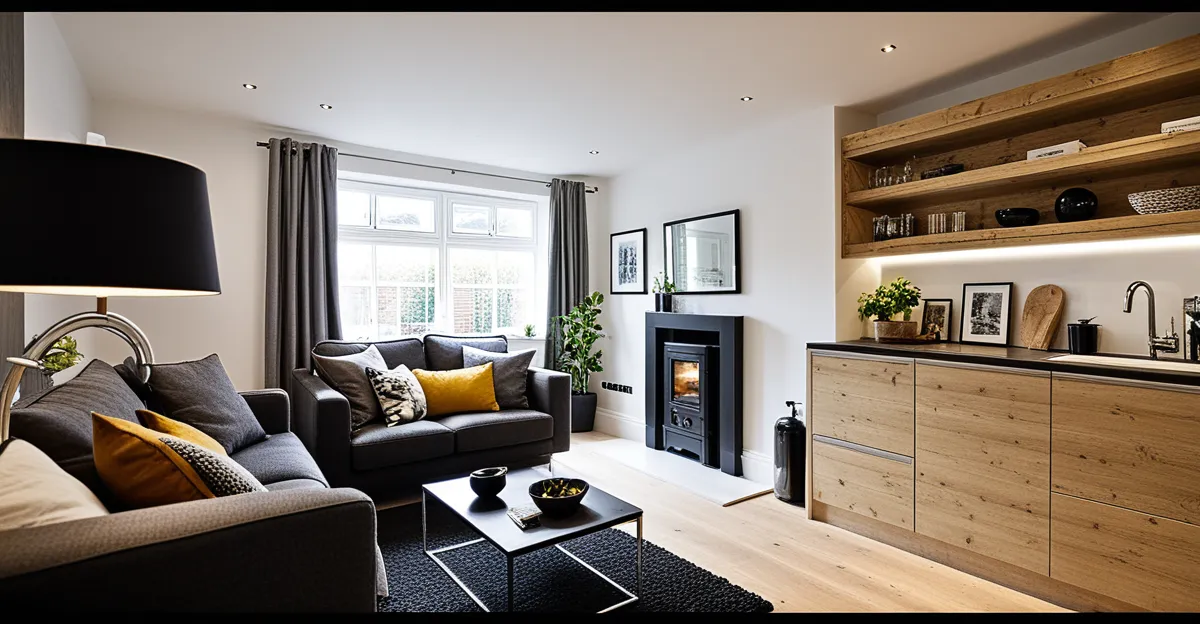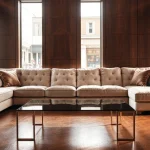Impact of Small Space Living on UK Interior Design Choices
Small space living in the UK presents unique space constraints that significantly influence interior design decisions. Many British homes, including terraced houses, Victorian conversions, and flats, feature compact layouts shaped by historical architectural styles and limited square footage. These characteristics require designers and homeowners to adopt creative solutions tailored to smaller footprints.
UK interior design approaches for small spaces emphasize maximizing functionality without sacrificing aesthetic appeal. The typical challenges include narrow rooms, limited storage, and often older building elements like uneven floors or thick walls, which restrict customization options. For example, Victorian conversions often have multiple small rooms instead of open-plan layouts, forcing innovative spatial planning to create light and flow.
Topic to read : How Can Home Automation Revolutionize the Way We Live in the UK?
Climate also plays a role; the UK’s frequently overcast weather encourages designs that optimize natural light to make spaces feel brighter and larger. Hard surfaces and lighter colour palettes are commonly used to reflect available light, enhancing the perception of space. Additionally, outdated insulation in many British homes necessitates consideration of energy efficiency in design choices, encouraging the integration of modern materials alongside the preservation of period features.
In summary, small space living UK conditions require a delicate balance between preserving traditional elements and implementing modern interior design techniques to overcome the inherent space constraints of British homes.
Also to discover : What Are the Most Common Mistakes People Make in Home Decor?
Practical Space-Saving Design Tips for Compact UK Homes
Small space living UK demands smart, effective strategies to maximise every inch of available room. One of the foremost space-saving tips for compact British homes is embracing decluttering and minimalism. Reducing unnecessary items helps create an open, breathable environment, which is vital when dealing with tight floor plans typical of many British homes. Minimalist interiors also facilitate easier maintenance and enhance the visual flow, crucial in rooms where space constraints limit movement.
Optimising natural light is another cornerstone of UK interior design tips tailored for small living. Given the often overcast climate, increasing the amount of daylight within rooms brightens spaces and makes them feel significantly larger. This can be achieved through strategic window treatments such as light, sheer curtains, alongside reflective surfaces and light colour palettes. Positioning furniture to avoid blocking light pathways further improves brightness and spatial perception.
Layout plays a pivotal role as well. Compact living requires careful arrangement of furniture to maintain functional zones without overcrowding. Flexible furniture pieces and open-plan configurations are encouraged when possible, even in traditionally divided spaces found in many UK homes. For instance, moving from conventional seating arrangements to modular sofas or foldaway desks can free up precious floor area.
Colour use and mirrors serve to enhance small room appearance too. Selecting light tones for walls and ceilings amplifies ambient light, while mirrors create an illusion of depth. Placing mirrors opposite windows or lighting fixtures doubles the light reflection and extends visual boundaries, helping to counteract the compactness characteristic of many UK interiors.
Together, these small home solutions combine to address the distinctive challenges posed by space constraints in UK residential design. By integrating decluttering, natural light optimisation, clever layouts, and visual enhancement, homeowners can transform compact rooms into comfortable and stylish living areas.
Furniture and Storage Solutions for UK Small Spaces
In small space living UK, selecting the right space-saving furniture UK is essential to maximise functionality without clutter. Multi-functional pieces like sofa beds, extendable dining tables, and nesting stools offer versatility, adapting to diverse needs in compact British homes. For example, a foldaway desk can transform a living area into a workspace without permanently occupying floor space.
Storage ideas often focus on utilising vertical and hidden areas to cope with limited footprints. Vertical shelving units help free up floor space while accommodating books, decorative items, or kitchen essentials. In the context of older British homes with quirky layouts, built-in storage solutions custom-fitted to alcoves, under stairs, or awkward corners make effective use of otherwise neglected space.
Creative storage also includes using furniture with integrated compartments, like ottomans or beds with under-bed drawers. These smart methods address the space constraints inherent in many British homes, where conventional bulky furniture would overpower interiors. By combining multi-functional furniture with innovative storage, small UK homes can maintain order and style simultaneously—crucial for comfortable compact living.
Furniture and Storage Solutions for UK Small Spaces
Effective space-saving furniture UK is essential for managing the space constraints inherent in many British homes. Multi-functional furniture pieces, such as sofas that convert into beds or ottomans with hidden storage, serve dual purposes and reduce clutter. Modular furniture further supports flexibility in compact living by allowing residents to rearrange seating or surfaces as needs change. These options are particularly useful in flats and terraced houses where space is limited and usage must be optimized.
Vertical storage solutions are a practical method to exploit often overlooked areas in UK interiors. Tall shelving units, wall-mounted storage, and bookcases utilize height rather than floor space, helping to keep rooms tidy without crowding the living area. Creative built-in storage options, like cupboards integrated into alcoves or staircases, are well-suited for traditional British homes, such as Victorian conversions, where structural features can be leveraged to enhance storage without altering the footprint.
Smart storage ideas specifically address awkward or underutilized spaces common in UK properties. Areas beneath stairs or narrow corridors can be transformed into cupboards or shelving, increasing functionality while maintaining clean lines in the home. Employing customized storage units that fit irregular wall shapes or recesses maximizes every available inch, which is vital for small space living UK. These strategies not only declutter the environment but also contribute to a cohesive and visually balanced interior design.
Adapting Older UK Homes to Modern Small Space Living
Older homes UK, particularly period properties, present unique challenges for small space living UK due to their traditional layouts and architectural features. Many Victorian or Edwardian houses have compartmentalised rooms, narrow corridors, and thick walls that limit flexible interior design options. These constraints require thoughtful period property design to both respect the building’s character and enhance usability for contemporary lifestyles.
Adapting small spaces in older homes UK often begins with retrofitting for improved efficiency. Upgrading insulation is crucial, as many historic properties suffer from poor thermal performance, making energy conservation an important consideration alongside aesthetics. Improved lighting strategies, including additional light sources and reflective surfaces, also help brighten interiors that otherwise feel cramped and dim.
Built-in storage is another vital element. Custom cupboards or shelving fitted into alcoves, beneath stairs, or within chimney breasts utilise awkward spaces typical of older homes. This approach balances functionality with the preservation of original features, ensuring that older homes UK maintain charm without sacrificing modern practicality.
For instance, a typical Victorian terrace may be modernised by removing non-load-bearing walls to create open-plan areas, integrating multi-purpose furniture, and installing efficient heating and insulation. Such adaptations allow period properties to meet contemporary living needs while respecting their historic essence, making small space living UK in older homes both feasible and appealing.
Impact of Small Space Living on UK Interior Design Choices
Small space living UK is deeply influenced by distinctive characteristics of British homes such as terraced houses, flats, and Victorian conversions. These property types often come with notable space constraints including narrow rooms, compartmentalized layouts, and structural features like thick walls or uneven floors. Such elements dictate a decidedly different interior design approach compared to more spacious modern homes.
The limited space shapes design in multiple ways. Firstly, functionality takes precedence: every item and furnishing must serve purpose without overwhelming the area. Secondly, designers employ creative spatial planning to enhance flow and usability, overcoming the challenges posed by rooms that may be small and irregularly shaped. For example, in Victorian conversions with multiple small rooms, interior design focuses on creating visual continuity and maximising usable square footage, often through clever partitioning or multi-use areas.
Climate also plays a significant role in determining design choices for small UK homes. The country’s frequent overcast weather prompts designs that optimise natural light, using light colours and reflective surfaces to make rooms feel brighter and more spacious. Additionally, the older housing stock’s often outdated insulation requires designers to incorporate modern efficiency solutions—like secondary glazing or insulated curtains—without compromising the period property’s character.
Altogether, small space living UK necessitates an interior design balance that respects the quirks and history of British homes while innovatively addressing significant space constraints. This results in tailored design strategies uniquely suited to the UK’s architectural heritage and living conditions.
Impact of Small Space Living on UK Interior Design Choices
Small space living UK fundamentally shapes the approach to interior design due to prevalent space constraints in British homes. Many properties, such as terraced houses, Victorian conversions, and flats, feature compact footprints with inherently segmented room layouts. This compartmentalisation limits opportunities for open-plan designs, demanding creative solutions to optimise flow and usability.
A core challenge in small space living UK is managing these physical constraints while maintaining both comfort and style. Narrow corridors, small kitchens, and limited storage force designers to prioritise multifunctional elements and clever spatial arrangements. For example, traditional Victorian homes often have thick walls and uneven floors, complicating structural modifications but inviting bespoke cabinetry and built-ins that fit irregular spaces.
Climate also plays a vital role in influencing design. The UK’s often grey and overcast weather elevates the importance of maximising natural light to counteract the compactness of these homes. Lighter colour schemes, reflective surfaces, and strategic window treatments are thus incorporated within interior design to brighten interiors and visually expand small rooms.
Additionally, the older housing stock prevalent across the UK brings an added layer of complexity. Energy inefficiency in many period properties necessitates retrofitting for improved insulation and heating without compromising historic features. Balancing preservation with modern living demands is a defining characteristic of adapting British homes to small space living.
Together, these factors create a distinctive framework where the limitations of space constraints are met with innovative interior design strategies tailored specifically to UK homes, blending traditional architecture with contemporary needs.











